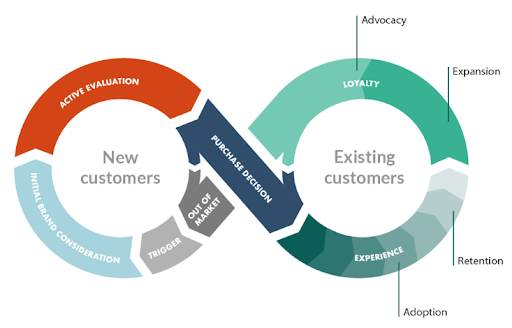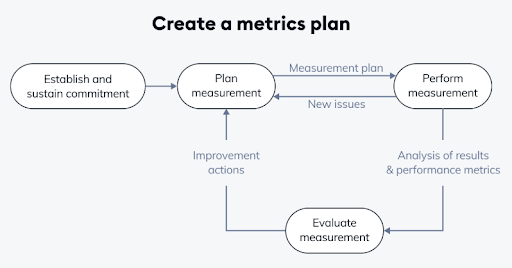Customer acquisition may help a company generate revenue. However, without customer retention, it’s difficult for a business to survive in the competitive landscape.
The success of a company in the long run depends on the joint efforts of two domains: sales and customer success. One focuses on conversions and generating business for you, whereas the other aims for customer satisfaction and brand advocacy.
The collaboration between the sales personnel and your customer success team makes it possible for you to ensure lasting customer relationships and grow your business.
In this article, we will talk about how customer sales and customer success work together, along with some useful tips to ensure success.
So, without further ado, let’s dive in.
#mc_embed_signup{background:#fff; false;clear:left; font:14px Helvetica,Arial,sans-serif; width: px;}
/* Add your own Mailchimp form style overrides in your site stylesheet or in this style block.
We recommend moving this block and the preceding CSS link to the HEAD of your HTML file. */
Sign Up for The Start Newsletter
(function($) {window.fnames = new Array(); window.ftypes = new Array();fnames[0]=’EMAIL’;ftypes[0]=’email’;fnames[1]=’FNAME’;ftypes[1]=’text’;fnames[2]=’LNAME’;ftypes[2]=’text’;fnames[3]=’ADDRESS’;ftypes[3]=’address’;fnames[4]=’PHONE’;ftypes[4]=’phone’;}(jQuery));var $mcj = jQuery.noConflict(true);
How Sales and Customer Success Work Together
Sales and customer success may be independent domains in a company, but they share a few similarities. Apart from their exclusive responsibilities, there are a few collective goals that both sales and customer services strive to achieve.
Understanding Customers
Knowing your audience helps you score sales and ensure customer retention in the long run. You need customer insights to pitch your solutions to the right audience and convince them to consider buying.
Similarly, familiarizing yourself with your audience’s preferences helps you meet their expectations and prevents your customers from considering other alternatives in the industry.
Useful customer insights allow you to identify the pain points of your target audience and learn how to cater to their concerns smartly.
Getting acquainted with your customers makes it possible for you to offer personalized experiences throughout the buyer’s journey. It not only helps you attract new customers but also improves your retention.
Your sales personnel gather customer insights by interacting with them through different channels of communication, such as live chat, email, social media, and more.
The same goes for your customer success personnel. Plus, they conduct customer satisfaction and feedback surveys to gather useful information.
Knowledge sharing plays a critical role here and helps both sales and customer success representatives achieve the set goals.
Free Online Skills Training: From Creating Personas to Reading Financial Reports
Generating Revenue
When it comes to generating revenue, sales and customer success play direct and indirect roles, respectively.
Your sales personnel are responsible for generating leads, nurturing them, and scoring conversions. Hence, revenue generation serves as one of the core indicators that highlight their performance.
Customer success professionals try to improve retention and brand loyalty. They make sure that you fulfill the promises made to customers when they interact with you, which fuels advocacy.

Happy customers contribute to you generating leads through referrals, making it easier for you to generate more revenue.
Effective collaboration between sales and customer success paves the way for you to grow consistently and stay ahead of the curve.
Ensuring Customer Loyalty
Sales and customer service work closely to amplify customer engagement, which in turn improves loyalty.
The teams ensure that your customers get optimal value from the products or services. Plus, they work together to ensure that the solutions you offer meet your customers’ expectations.
It takes more than just scoring sales to make your business grow. You need to strive for undying loyalty as it transforms your customers into brand ambassadors, fueling social proof and setting you on the path to consistent growth.
Sales and customer success collaborate to help you offer an enhanced customer experience throughout their journey. You are able to keep up with customer expectations that change over time and pivot to achieve success in the long run.
How to Drive Customer Loyalty Through Exceptional Post-Purchase Experiences
Useful Tips for Success
You must improve coordination between your sales and customer success personnel to acknowledge consistent growth. Here are a few noteworthy recommendations that can help:
Set Clear Goals
The first step to achieving success as a growing business is to set actionable goals. You should also communicate your goals clearly so your teams know what you expect from them.
You can’t expect your teams to perform when you’re unaware of your destination. Your goals help you keep things on track and make it possible for you to assign responsibilities to the key stakeholders.
For example, your sales teams are responsible for bringing in quality leads and closing the deals to help you generate revenue. On the other hand, customer success is responsible for retaining your customers and improving brand advocacy.
For both teams to meet your expectations, you need to communicate these responsibilities clearly. It eliminates the possibility of them getting sidetracked, and helps you get optimal results from your efforts.
6 CRM Trends That Drive Customer Satisfaction and Loyalty
Deploy the Right Performance Metrics
You should constantly track the performance of your teams to make sure that you’re on the right path. Identifying and implementing the right key performance metrics play a critical role in that regard.

For example, the metrics that help you assess the performance of your sales department can be the number of leads generated over a period, lead quality score, conversion rate, customer acquisition cost, and so on.
Fitting indicators to measure the performance of your customer acquisition team can be churn rate, customer health score, net promoter score, customer lifetime value, referral rate, etc.
If you observe closely, the indicators representing both sales and customer success teams may be different yet intertwined to help you grow.
Choosing the right metrics for your operations and monitoring them enables you to ensure that both sales and customer success fulfill the assigned responsibilities, bringing you closer to achieving the goals you set and ensuring smooth cross functional collaboration.
Measure Performance
The way your sales teams operate can affect the performance of your customer success. Similarly, your customer success team’s effectiveness can make it easier for you to generate more sales.
For example, it will be very difficult for your customer success team to meet the expectations of your customer base and ensure high satisfaction if your sales team resorts to overpromising to close the deal.
Likewise, customer success excellence helps you build a rapport in your respective industry and fuels social proof. It helps your sales team attract new prospects and maintain a high conversion rate.
Therefore, you should consistently track the performance of both domains and see that they fulfill the assigned duties, as the performance of one can influence the success of another.
Campaigner Marketing
Drive higher ROI, grow your audience and build more loyal customers with Campaigner’s advanced email marketing features.

Improve Knowledge Sharing
You should have a knowledge base or customer management system in place to facilitate information sharing and easy data access to drive the best results from your sales and customer success initiatives.
Customer data helps both your sales and customer success representatives perform their jobs well, which improves customer retention and loyalty.
You successfully cater to the pain points of your customers and establish a strong bond with them. It becomes easier for both teams to keep up with their deliverables and enable you to offer a seamless pre and post-sales experience.
Leverage Data to Minimize Friction
You should focus on collecting data and customer insights across all touch points in the customer journey. You can consider conducting surveys, leveraging social media to assess audience sentiment, and analyzing customer support tickets to familiarize yourself with the pain points of your customers.
Customer data helps you get acquainted with your audience’s interests and expectations. The goals of your customers keep changing over time. Therefore, you need constant access to such information that enables you to minimize friction in the buyer’s journey and ensure a seamless transition of prospects from one stage to another.
The data helps you attract and engage customers with ease. Plus, it enables you to tailor the experience you offer to the changing needs of your customers. As a result, you maintain lasting relationships with your customers and cultivate undying loyalty.
Why Your Startup Needs Solid and Robust Data Pipelines
Ensure Effective Communication
When your sales and customer success teams operate in silos, it minimizes your chances of achieving success. They need to go hand-in-hand to identify the right customers and set them on the path to becoming your brand ambassadors.
Effective communication ensures that both domains perform at their absolute best. Therefore, you need to keep a close eye to identify communication discrepancies and loopholes in the information handover process.
You should also encourage brainstorming sessions to enhance synergy and devise fruitful ideas that can help you acknowledge lasting customer relationships. It can also help with identifying potential upselling or cross-selling opportunities, enabling you to grow your revenue exponentially.
Over to You
If you’ve been curious about how sales and customer success work together to help you grow, now you know.
Collaboration between both domains helps you score more sales and establish strong ties with your customer base.
You can get started by setting clear goals and selecting the right metrics to assess the performance of your teams.
You should also focus on improving information sharing and ensuring effective communication as it enables you to leverage data to offer an enhanced experience throughout a customer’s lifespan.
Photo by Jose Vazquez on Unsplash
Verizon Small Business Digital Ready
Find free courses, mentorship, networking and grants created just for small businesses.

The post Customer Success and Sales: Best Practices for a Profitable Fit appeared first on StartupNation.


